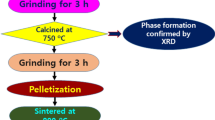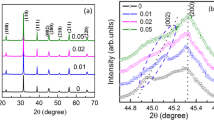Abstract
We report the effect of partial substitution of Dy3+ rare earth ion in NBT-BT lead free ceramics on its structural, microstructural, ferroelectric and dielectric phase transitions. The Rietveld refined X-ray diffraction analysis revealed a coexistence of dual phase with major monoclinic (Cc) along with minor tetragonal (P4mm) in all Dy-NBT-BT ceramics. The T-dependent dielectric broad band spectroscopic study revealed that Dy-substituted NBT-BT ceramics exhibits two diffuse dielectric anomalies renowned as Ferro (FE) to anti Ferro (AFE) i.e., depolarization phase transition (\(T_{d}\)) and Antiferro (AFE) to paraelectric (PE) i.e., curie phase transition (\(T_{C}\)), below 150 °C and well above 300 °C temperature regions respectively. The complex frequency dependent dielectric and modulus spectroscopy analysis supports the Non-Debye type dielectric relaxation process was dominated for all the measured ceramics. T-dependent AC-conductivity study revealed, thermally activated charge carries and single ionized oxygen vacancies are found to contribute conduction process at different temperature regions. Room temperature polarization hysteresis (P–E) loops analysis exposed a slim asymmetric shape with Dy substitution increasing that indicates conversion of hard to soft ferroelectric character. Remnant polarisation (\(P_{r}\)) and coercive field (\(E_{c}\)) decreases with dopant concentration shows the tetragonality dominance with Dy substitution. Furthermore, an optimum recoverable energy density 1.477 J/cm3 was obtained in NBT-BT at Dy = 0.03 compositions that designate the materials could be useful for future high energy storage density applications.










Similar content being viewed by others
References
G.A. Smolenskii, A.I. Agranovskaya, Dielectric polarization of a number of complex compounds. Sov Phys. Solid State 1, 1429–1437 (1960)
D. Viehland, S.J. Jang, L.E. Cross, M. Wuttig, Freezing of the polarization fluctuations in lead magnesium niobate relaxors. J. Appl. Phys. 68, 2916–2921 (1990)
L.E. Cross, Relaxor ferroelectrics. Ferroelectrics 76, 241–267 (1987)
E. Aksel, J.S. Forrester, J.L. Jones et al., Monoclinic crystal structure of polycrystalline Na0.5Bi0.5TiO3. Appl. Phys. Lett. 98, 152901 (2011)
E. Aksel, J.S. Forrester, B. Kowalski et al., Phase transition sequence in sodium bismuth titanate observed using high-resolution x-ray diffraction. Appl. Phys. Lett. (2011). https://doi.org/10.1063/1.3664393
B. Noheda, D.E. Cox, G. Shirane et al., A monoclinic ferroelectric phase in the Pb(Zr1−xTix)O3 solid solution. Appl. Phys. Lett. 74, 2059–2061 (1999)
B. Noheda, D.E. Cox, G. Shirane et al., Polarization rotation via a monoclinic phase in the piezoelectric 92% PbZn1/3Nb2/3O3-8% PbTiO3. Phys. Rev. Lett. 86, 3891 (2001)
B. Noheda, D.E. Cox, G. Shirane et al., Phase diagram of the ferroelectric relaxor (1–x) PbMg1/3Nb2/3O3−xPbTiO3. Phys. Rev. B 66, 54104 (2002)
F. Bai, N. Wang, J. Li et al., X-ray and neutron diffraction investigations of the structural phase transformation sequence under electric field in 0.7Pb(Mg1/3Nb2/3)-0.3PbTiO3 crystal. J. Appl. Phys. 96, 1620–1627 (2004)
B.N. Rao, R. Ranjan, Electric-field-driven monoclinic-to-rhombohedral transformation in Na1/2Bi1/2TiO3. Phys. Rev. B 86, 134103 (2012)
K. Thangavelu, S. Asthana, Monoclinic Cc-phase stabilization in magnetically diluted lead free Na1/2Bi1/2TiO3: evolution of spin glass like behavior with enhanced ferroelectric and dielectric properties. Mater. Res. Express 2, 96301 (2015)
G.A. Smolensky, New ferroelectrics of complex composition. IV. Sov Phys. Solid State 2, 2651–2654 (1961)
C.F. Buhrer, Some properties of bismuth perovskites. J. Chem. Phys. 36, 798–803 (1962)
J. Suchanicz, K. Roleder, A. Kania, J. Hańaderek, Electrostrictive strain and pyroeffect in the region of phase coexistence in Na0.5Bi0.5TiO3. Ferroelectrics 77, 107–110 (1988)
K. Roleder, J. Suchanicz, A. Kania, Time dependence of electric permittivity in Na0.5Bi0.5TiO3 single crystals. Ferroelectrics 89, 1–5 (1989)
K. Sakata, Y. Masuda, Ferroelectric and antiferroelectric properties of (Na0.5Bi0.5)TiO3-SrTiO3 solid solution ceramics. Ferroelectrics 7, 347–349 (1974)
D. Lin, K.W. Kwok, Dielectric and piezoelectric properties of (Bi1−x−yNdxNa1−y)0.5BayTiO3 lead-free ceramics. Curr. Appl. Phys. 10, 422–427 (2010)
Y. Li, W. Chen, Q. Xu et al., Piezoelectric and ferroelectric properties of Na0.5Bi0.5TiO3– K0.5Bi0.5TiO3–BaTiO3 piezoelectric ceramics. Mater. Lett. 59, 1361–1364 (2005)
C. Peng, J.-F. Li, W. Gong, Preparation and properties of (Bi1/2Na1/2)TiO3–Ba(Ti, Zr)O3 lead-free piezoelectric ceramics. Mater. Lett. 59, 1576–1580 (2005)
Z. Chen, J. Hu, Piezoelectric and dielectric properties of (Bi0.5Na0.5)0.94 Ba0.06TiO3–Ba(Zr0.04Ti0.96)O3 lead-free piezoelectric ceramics. Ceram. Int. 35, 111–115 (2009)
C. Zhou, X. Liu, W. Li, C. Yuan, Microstructure and electrical properties of Bi0.5Na0.5TiO3–Bi0.5K0.5TiO3–LiNbO3 lead-free piezoelectric ceramics. J. Phys. Chem. Solids 70, 541–545 (2009)
D.Z. Zhang, X.J. Zheng, X. Feng et al., Ferro-piezoelectric properties of 0.94(Na0.5Bi0.5)TiO3–0.06BaTiO3 thin film prepared by metal–organic decomposition. J. Alloys Compd. 504, 129–133 (2010)
C. Ma, X. Tan, Phase diagram of unpoled lead-free (1–x)(Bi1/2Na1/2)TiO3–xBaTiO3 ceramics. Solid State Commun. 150, 1497–1500 (2010)
Z. Yang, B. Liu, L. Wei, Y. Hou, Structure and electrical properties of (1–x) Bi0.5Na0.5TiO3–x Bi0.5K0.5TiO3 ceramics near morphotropic phase boundary. Mater. Res. Bull. 43, 81–89 (2008)
W.-C. Lee, C.-Y. Huang, L.-K. Tsao, Y.-C. Wu, Crystal Structure, dielectric and ferroelectric properties of (Bi0.5Na0.5)TiO3–(Ba, Sr)TiO3 lead-free piezoelectric ceramics. J. Alloys Compd. 492, 307–312 (2010)
M. Zou, H. Fan, L. Chen, W. Yang, Microstructure and electrical properties of (1–x)[0.82Bi0.5Na0.5TiO3–0.18Bi0.5K0.5TiO3]–xBiFeO3 lead-free piezoelectric ceramics. J. Alloys Compd. 495, 280–283 (2010)
T. Takenaka, K. Maruyama, K. Sakata, (Bi1/2Na1/2)TiO3-BaTiO3 system for lead-free piezoelectric ceramics. Jpn. J. Appl. Phys. 30, 2236 (1991)
M. Chen, Q. Xu, B.H. Kim et al., Structure and electrical properties of (Na0.5Bi0.5)1−xBaxTiO3 piezoelectric ceramics. J. Eur. Ceram. Soc. 28, 843–849 (2008)
B.J. Chu, D.R. Chen, G.R. Li, Q.R. Yin, Electrical properties of Na1/2Bi1/2TiO3-BaTiO3 ceramics. J. Eur. Ceram. Soc. (2002). https://doi.org/10.1016/S0955-2219(02)00027-4
H. Du, W. Zhou, F. Luo et al., An approach to further improve piezoelectric properties of (K0.5Na0.5)NbO3-based lead-free ceramics. Appl. Phys. Lett. 91, 202907 (2007)
D. Lin, K.W. Kwok, H.W.L. Chan, Dielectric and piezoelectric properties of (K0.5Na0.5)NbO3–Ba(Zr0.05Ti0.95)O3 lead-free ceramics. Appl. Phys. Lett. 91, 143513 (2007)
G. Fan, W. Lu, X. Wang, F. Liang, Morphotropic phase boundary and piezoelectric properties of (Bi1/2Na1/2)TiO3–(Bi1/2K1/2)TiO3–KNbO3 lead-free piezoelectric ceramics. Appl. Phys. Lett. 91, 202908 (2007)
B.K. Barick, R.N.P. Choudhary, D.K. Pradhan, Phase transition and electrical properties of lanthanum-modified sodium bismuth titanate. Mater. Chem. Phys. 132, 1007–1014 (2012)
M. Raghavender, G.S. Kumar, G. Prasad, A-site substitution-controlled dielectric dispersion in lead-free sodium bismuth titanate. Pramana 72, 999–1009 (2009)
M. Zannen, A. Lahmar, M. Dietze et al., Structural, optical, and electrical properties of Nd-doped Na0.5Bi0.5TiO3. Mater. Chem. Phys. 134, 829–833 (2012)
M. Zannen, H. Khemakhem, A. Kabadou, M. Es-Souni, Structural, Raman and electrical studies of 2 at.% Dy-doped NBT. J. Alloys Compd. 555, 56–61 (2013)
A.M. Gonzalez, L. Pardo, M.E. Montero-Cabrera, L.E. Fuentes-Cobas, Analysis of the rhombohedral–tetragonal symmetries coexistence in lead-free 0.94(Bi0.5Na0.5)TiO3–0.06BaTiO3 ceramics from nanopowders. Adv. Appl. Ceram. 115, 96–105 (2016)
F. Qiang, J.-H. He, J. Zhu, X.-B. Chen, Ferroelectric and dielectric properties of bismuth-layered structural Sr2Bi4−xLnxTi5O18 (Ln= La, Nd, Sm and Dy) ceramics. J. Solid State Chem. 179, 1768–1774 (2006)
Y. Noguchi, M. Miyayama, T. Kudo, Direct evidence of A-site-deficient strontium bismuth tantalate and its enhanced ferroelectric properties. Phys. Rev. B 63, 214102 (2001)
Y. Noguchi, M. Miyayama, T. Kudo, Effect of Bi substitution at the Sr site on the ferroelectric properties of dense strontium bismuth tantalate ceramics. J. Appl. Phys. 88, 2146–2148 (2000)
K. Uchino, S. Nomura, Critical exponents of the dielectric constants in diffused-phase-transition crystals. Ferroelectrics 44, 55–61 (1982)
J.R. Macdonald, Impedance spectroscopy. Ann. Biomed. Eng. 20, 289–305 (1992)
V.F. Lvovich, Impedance Spectroscopy: Applications to Electrochemical and Dielectric Phenomena (Wiley, Hoboken, 2012).
K.W. Wagner, The theory of incomplete dielectricity. Ann. Phys. 40, 817 (1913)
C.G. Koops, On the dispersion of resistivity and dielectric constant of some semiconductors at audiofrequencies. Phys. Rev. 83, 121 (1951)
K. Datta, P.A. Thomas, K. Roleder, Anomalous phase transitions of lead-free piezoelectric x Na0.5Bi0.5TiO3−(1–x) BaTiO3 solid solutions with enhanced phase transition temperatures. Phys. Rev. B 82, 224105 (2010)
L. Chauhan, A.K. Shukla, K. Sreenivas, Dielectric and magnetic properties of Nickel ferrite ceramics using crystalline powders derived from DL alanine fuel in sol–gel auto-combustion. Ceram. Int. 41, 8341–8351 (2015)
K. Chen, J. Hyodo, N. Ai, T. Ishihara, Boron deposition and poisoning of La0.8Sr0.2MnO3 oxygen electrodes of solid oxide electrolysis cells under accelerated operation conditions. Int. J. Hydrogen Energy 41, 1419–1431 (2016)
R. Waser, T. Baiatu, K. Härdtl, dc electrical degradation of perovskite-type titanates: I, ceramics. J. Am. Ceram. Soc. 73, 1645–1653 (1990)
T.-F. Zhang, X.-G. Tang, Q.-X. Liu et al., Oxygen-vacancy-related relaxation and conduction behavior in (Pb1–x Bax)(Zr0.95Ti0.05)O3 ceramics. AIP Adv. 4, 107141 (2014)
A. Dutta, T.P. Sinha, Dielectric relaxation in perovskite BaAl1/2Nb1/2O3. J. Phys. Chem. Solids 67, 1484–1491 (2006)
M.M. Costa, G.F.M. Pires Jr., A.J. Terezo et al., Impedance and modulus studies of magnetic ceramic oxide Ba2Co2Fe12O22 (Co2Y) doped with Bi2O3. J. Appl. Phys. 110, 34107 (2011)
P. Tirupathi, A. Chandra, Grain and grain boundary effects in Ca2+ doped BiFeO3 multiferroic ceramics. Phys. Status Solidi 249, 1639–1645 (2012)
J.R. Macdonald, Comments on the electric modulus formalism model and superior alternatives to it for the analysis of the frequency response of ionic conductors. J. Phys. Chem. Solids 70, 546–554 (2009)
T. Patri, P. Justin, P.D. Babu, A. Ghosh, Analysis of dielectric and magnetic phase transitions in Yb(Fe0.5Cr0.5)O3 bulk perovskite. Appl. Phys. A 125, 224 (2019)
M.S. Cao, X.X. Wang, M. Zhang et al., Electromagnetic response and energy conversion for functions and devices in low-dimensional materials. Adv. Funct. Mater. 29, 1–54 (2019). https://doi.org/10.1002/adfm.201807398
O. Bidault, P. Goux, M. Kchikech et al., Space-charge relaxation in perovskites. Phys. Rev. B 49, 7868 (1994)
M. Li, H. Zhang, S.N. Cook et al., Dramatic influence of A-site nonstoichiometry on the electrical conductivity and conduction mechanisms in the perovskite oxide Na0.5Bi0.5TiO3. Chem. Mater. 27, 629–634 (2015)
Y. Sun, H. Liu, H. Hao, S. Zhang, Effect of oxygen vacancy on electrical property of acceptor doped BaTiO3–Na0.5Bi0.5TiO3–Nb2O5 X8R systems. J. Am. Ceram. Soc. 99, 3067–3073 (2016)
T. Yan, X. Sun, J. Deng et al., Dielectric and conductivity behavior of Mn-doped K0.5Na0.5NbO3 single crystal. Solid State Commun. 264, 1–5 (2017)
J. Shieh, K.C. Wu, C.S. Chen, Switching characteristics of MPB compositions of (Bi0.5Na0.5)TiO3–BaTiO3–(Bi0.5K0.5)TiO3 lead-free ferroelectric ceramics. Acta Mater. 55, 3081–3087 (2007)
Q. Zhao, T. Sheng, L. Pang et al., Highly efficient and giant negative electrocaloric effect of a Nb and Sn co-doped lead zirconate titanate antiferroelectric film near room temperature. RSC Adv. 9, 34114–34119 (2019). https://doi.org/10.1039/c9ra06551b
F. Li, R. Zuo, D. Zheng, L. Li, Phase-composition-dependent piezoelectric and electromechanical strain properties in (Bi1/2Na1/2)TiO3–Ba(Ni1/1/2)O3 lead-free ceramics. J. Am. Ceram. Soc. 98, 811–818 (2015)
A. Chauhan, S. Patel, R. Vaish, Mechanical confinement for improved energy storage density in BNT-BT-KNN lead-free ceramic capacitors. AIP Adv. 4, 87106 (2014)
D. Wang, Z. Fan, D. Zhou et al., Bismuth ferrite-based lead-free ceramics and multilayers with high recoverable energy density. J. Mater. Chem. A 6, 4133–4144 (2018). https://doi.org/10.1039/c7ta09857j
W.P. Cao, W.L. Li, X.F. Dai et al., Large electrocaloric response and high energy-storage properties over a broad temperature range in lead-free NBT-ST ceramics. J. Eur. Ceram. Soc. 36, 593–600 (2016)
W. Cao, W. Li, T. Zhang et al., High-energy storage density and efficiency of (1–x)[0.94 NBT–0.06 BT]–xST lead-free ceramics. Energy Technol. 3, 1198–1204 (2015)
K.C. Sekhar, K.R. Kandula, K.S. Babu et al., Co-substitution of Er/Yb on structural and electrical properties of NKBT–BCZT solid solutions. SN Appl. Sci. 1, 1643 (2019)
Acknowledgements
The author KCS would like to acknowledge to Dr. V. Seshubai, UGC Networking resource Centre (UGC-NRC), School of Physics, University of Hyderabad for providing X-ray diffraction studies and Dr. A. M. Awasthi and Suresh Bharadwaj, UGC-DAE-CSR, Indore Centre for providing high temperature dielectric measurements. The author TP would like to thank UGC-DAE, BARC-India, for (UDCSR/MUM/CD/CRSM-261/2017) the project funded under the collaborator research scheme.
Author information
Authors and Affiliations
Corresponding author
Additional information
Publisher's Note
Springer Nature remains neutral with regard to jurisdictional claims in published maps and institutional affiliations.
Supplementary Information
Below is the link to the electronic supplementary material.
Rights and permissions
About this article
Cite this article
Chandra Sekhar, K.S.K.R., Mahesh, M.L.V., Sreenivasu, T. et al. Structural evolution, dielectric relaxation and modulus spectroscopic studies in Dy substituted NBT-BT ferroelectric ceramics. J Mater Sci: Mater Electron 32, 8628–8647 (2021). https://doi.org/10.1007/s10854-021-05506-4
Received:
Accepted:
Published:
Issue Date:
DOI: https://doi.org/10.1007/s10854-021-05506-4




